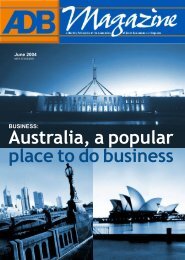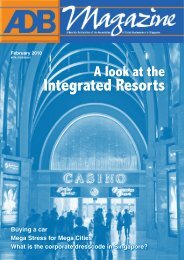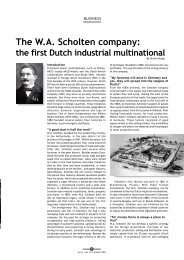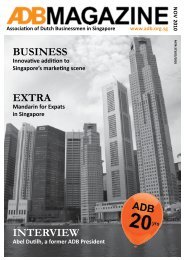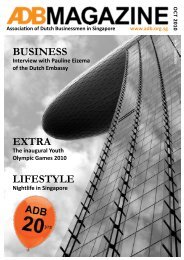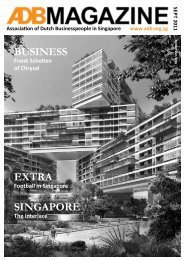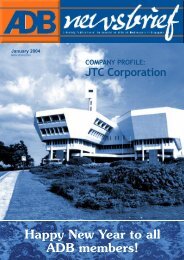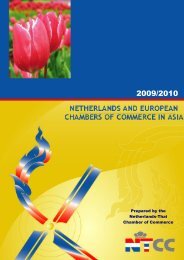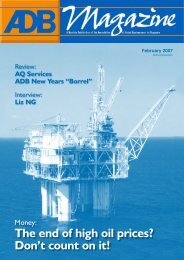June - July 2013 - Association of Dutch Businessmen
June - July 2013 - Association of Dutch Businessmen
June - July 2013 - Association of Dutch Businessmen
Create successful ePaper yourself
Turn your PDF publications into a flip-book with our unique Google optimized e-Paper software.
Business<br />
Car Racing in Singapore<br />
and Malaysia<br />
Interview with Wijnand Schagen<br />
Text Ay Wen Lie Photos Wijnand Schagen<br />
The F1- circus has been visiting Singapore for several years<br />
now, creating an exciting event each year in September.<br />
For Singaporeans, it’s an event impossible to miss. A less<br />
well-known fact is that there’s a whole range <strong>of</strong> other types<br />
<strong>of</strong> motorsports both in Singapore and in the region besides<br />
F1. There are many accessible forms <strong>of</strong> motorsports<br />
available which individuals or (corporate) groups can easily<br />
take part in.<br />
Wijnand Schagen, (ex-Yamaha test driver, licensed<br />
instructor and automotive engineer) tells us about the<br />
available options in Singapore and Malaysia. He talks about<br />
racing, improving your driving skills, hiring racing cars for<br />
on-track racing, and where to get engineering services to<br />
optimize performance <strong>of</strong> sports- and racecars.<br />
Can you give an overview <strong>of</strong> the Singapore motorsport<br />
scene?<br />
A popular form <strong>of</strong> motorsport in Asia is drifting, a driving<br />
technique whereby the driver intentionally causes the rear<br />
end <strong>of</strong> the car to slide at a great angle, while maintaining<br />
control from entry to exit <strong>of</strong> a corner. Specifically modified,<br />
rear wheel drive cars are used for this type <strong>of</strong> motorsport.<br />
Up and coming in Singapore is Gymkhana, a motorsport<br />
style whereby the driver must manoeuver through a<br />
pre-determined track, set out with cones on a big, empty<br />
parking lot. The driver must perform many different driving<br />
techniques, such as 180 degree spins, 360 degree spins,<br />
parking boxes, figure 8s, and other advanced skills. Any<br />
road car can be used, but a car equipped with a manual<br />
gearbox is more suitable than an automatic.<br />
On the road you see quite a lot <strong>of</strong> modified Japanese<br />
cars and high-end European sports cars. A number <strong>of</strong> these<br />
fast cars are being used from time to time on so-called<br />
Track Days, mostly on Sepang Formula One racetrack in<br />
Malaysia, near Kuala Lumpur. Track Days are organized by<br />
various driving clubs and provide the opportunity to drive<br />
your car around the racetrack as fast as you like. There<br />
is no competitive element here and no racing license is<br />
required for this.<br />
Ultimately, enthusiasts who want to engage in racing<br />
competitions can compete in top-level race classes in<br />
the region like GT Asia, Porsche Carrera Cup Asia, and<br />
Malaysian Super Series for Sports Prototypes, GTs and<br />
Touring Cars. Pr<strong>of</strong>essionally built, competition-dedicated<br />
racecars are used for these race series.<br />
What services do you provide?<br />
For motorsport enthusiasts who want to drive on a<br />
racetrack, I <strong>of</strong>fer track day experiences. This entails an<br />
Arrive & Drive concept, whereby a track-prepared rentalracecar<br />
is provided.<br />
The drivers’ level <strong>of</strong> driving experience varies, therefore<br />
a variety <strong>of</strong> rental-racecars is available, ranging from fast<br />
Touring Cars to lightweight, open-top Westfield Cup cars,<br />
up to very fast, big-winged Sports Prototypes. Usually<br />
people start out in a Touring Car, getting the hang <strong>of</strong><br />
driving on-track and getting used to the high levels <strong>of</strong><br />
grip a racecar generates, learning correct racing lines and<br />
getting a feel for the high cornering speeds. Then drivers<br />
progress onto Ariel Atom and Westfield Cup cars. These are<br />
lightweight, open top racing cars with an exciting power<br />
to weight ratio and lots <strong>of</strong> mechanical grip, making them<br />
significantly quicker than the Touring Cars. Speeds in these<br />
cars are higher, lap times are faster and the skills required<br />
to drive these cars are higher. Finally, it’s on to the Sports<br />
Prototypes. These ‘junior Le Mans’-cars generate a lot<br />
<strong>of</strong> down force and are seriously fast. It takes a while for<br />
your brain to adjust and accept how extremely late you<br />
can actually brake in such a car and how much speed you<br />
can carry through a corner. Very exciting stuff! It’s a great<br />
experience for drivers to learn how to drive all <strong>of</strong> these cars<br />
at racing speed and learn the skills required to do that.<br />
What else do you provide?<br />
For local car clubs, I provide instruction at club events, such<br />
as Gymkhana instruction at the Mazda MX5 club.<br />
Group-instruction can also be done at (corporate)<br />
karting events. Learning only a few basic things such as<br />
12



